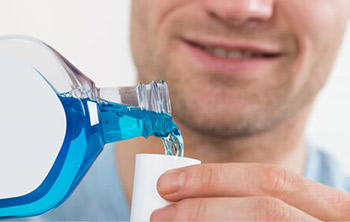Tooth Care

MOUTH RINSES
Rinses are generally classified by the U.S. Food and Drug Administration (FDA) as either cosmetic or therapeutic, or a combination of the two. Cosmetic rinses are commercial over-the-counter (OTC) products that help remove oral debris before or after brushing, temporarily suppress bad breath, diminish bacteria in the mouth and refresh the mouth with a pleasant taste. Therapeutic rinses have the benefits of their cosmetic counterparts, but also contain an added active ingredient that helps protect against some oral diseases.
Therapeutic rinses are regulated by the FDA and are voluntarily approved by the American Dental Association (ADA). Therapeutic rinses also can be categorized into types according to use: anti-plaque/anti-gingivitis rinses and anti-cavity fluoride rinses.
Some therapeutic rinses with fluoride have been shown to actually fight cavities, plaque and gingivitis formation. Cosmetic rinses merely treat breath odor, reduce bacteria and/or remove food particles in the mouth. They do nothing to treat periodontal disease or prevent gingivitis.
Anticavity rinses with fluoride have been clinically proven to fight up to 50% more of the bacteria that cause cavities. However, initial studies have shown that most over-the-counter antiplaque rinses and antiseptics are not much more effective against plaque and gum disease than rinsing with water. Most rinses are effective in curbing bad breath and freshening the mouth for up to three hours.
Surgery or oral disease sometimes leads to complications for which a good quality therapeutic rinse is indicated. Even people who have difficulty brushing (because of physical difficulties such as arthritis) can benefit from a good therapeutic mouth rinse.
Finally, mouth rinses, if used extensively, can stain teeth. Although mouth rinses do wash away debris and bacteria, they should never be used as permanent substitute for proper dental care.
In any case, make sure and look for indication on the label of a mouth rinse that is accepted by the American Dental Association.






